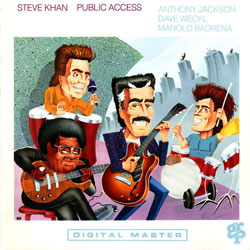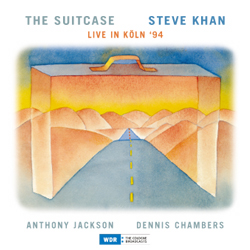

|
Soundclip:
|
| See Steve's Hand-Written Lead
Sheet |
|
Steve Khan’s "Blue
Zone 41"  It was an absolute pleasure to have him with us for this adventure,
and his performances speak volumes with memorable solos on both "Mama
Chóla" and "Kamarica." So, let's get to the music
at hand.
It was an absolute pleasure to have him with us for this adventure,
and his performances speak volumes with memorable solos on both "Mama
Chóla" and "Kamarica." So, let's get to the music
at hand. I guess one could say that "Blue Zone 41" really exists as a rather "oddball blues," replete with an off-handed reference to John Coltrane's "One Down, One Up," which appears on the classic recording: "NEW THING AT NEWPORT"(Impulse). As in the Coltrane composition, "Blue Zone 41" was created around a very simple rhythmic idea, coupled with the usage of an augmented triad, which can be viewed in bars 1-4 of [I]. A secondary melodic piece first appears in bars 5-6, and this theme will reappear throughout the tune as well as serving as important thematic material to be explored during the improvisation. This piece was written knowing that it would be performed by the brilliant Anthony Jackson and it allowed him to explore many of the possibilities of his 6-string contrabass guitar as we double some of the important lines in the tune. For example, the lines which appear at [I]and later during [A], at bar 17; and finally during the [Tag]. As we arrive at the melody section, [A], the piece takes an elongated path to work its way from an F7, the I7 in this piece, to its arrival at the IV7 chord, Bb7, at bar 15, instead of the more traditional bar 5. This main melodic section utilizes our primary theme in bars: 1-4; 9-10; 19-22; and 25-26. The secondary theme reappears in bars: 5-6 and 15-16. There's also quite an extended harmonic 'journey' to travel from the F7 to Bb7, which happens between bars 11-14 and actually passes over Bb twice! In bars 11-12, I offer my own little twist on "Giant Steps" changes. Perhaps more reminiscent for the running 8th notes in the melody and the half-notes in the bass than for the specific harmonic movement(the chord changes), which is not exactly the same as 'Trane's. As we arrive at the IV7 chord, Bb7, the secondary theme reappears, and after a brief break, and unison line, we pass through a B°7 which often appears in bar 6 of a 'traditional' jazz-oriented blues structure. From this point forward, we continue to work our way around various dominant 7th areas which are all, in essence, part of the F whole-tone scale(F, G, A, B, Db, Eb). Finally, at bars 11-15 of [B], we land on Ab7(13) for the beginning of the improvised section. This small little 4-bar section is intended to serve as a 'rocket'(a harmonic send-off) into the solo. The solo section, [C], and its format are worth exploring because it alternates between a section which is open-ended, with an Ab7 tonal center, and then, a 2nd section which takes us back to F7. My cues to transit these two areas were given to bits and pieces of imperfection, but Anthony and Dave Weckl were tremendously flexible in interpreting my wishes. As a cue out of the final F7 section, I simply begin to play [I] and then expect, or should I say hope that Anthony and Dave are going to hear that and 'catch-up' to me as soon as is possible. During the recorded solo, you hear a 'mini guitar orchestra' come in on occasion and these sounds were provided by my KORG DVP-1, which is essentially a harmonizer. The idea for this sound came from working with Joe Zawinul as part of Weather Update in '86.  Joe used to do something very similar with his "Prophet 5"
keyboard and he was kind enough to explain the 'unison lock'
feature which seems to 'capture' a just-played voicing, and then, once
it has been pressed in, everything you play is that voicing in parallel.
To accomplish something similar, I set-up all my voicings in the DVP-1
so that the note I played on my guitar was always the top voice. For
this tune, as it is supposed to have a 'bluesy' flavor to it, I chose
to use all parallel dominant 7th chord voicings. I used this device
while playing bits and pieces of thematic material from the tune, to
answer phrases I was playing in single notes. It's as if a "big band"
is responding to what I've played. One program I used had the 5th
on top, and you could program this yourself by setting your harmonizer
voices to: [-3] [-7] [-9] with those degrees referring to the half-steps
down from the note I'm playing. The other voicing I like has the 3rd
on top and is: [-4] [-6] [-9]. If you have a harmonizer in your
rack, give these a try. Joe used to do something very similar with his "Prophet 5"
keyboard and he was kind enough to explain the 'unison lock'
feature which seems to 'capture' a just-played voicing, and then, once
it has been pressed in, everything you play is that voicing in parallel.
To accomplish something similar, I set-up all my voicings in the DVP-1
so that the note I played on my guitar was always the top voice. For
this tune, as it is supposed to have a 'bluesy' flavor to it, I chose
to use all parallel dominant 7th chord voicings. I used this device
while playing bits and pieces of thematic material from the tune, to
answer phrases I was playing in single notes. It's as if a "big band"
is responding to what I've played. One program I used had the 5th
on top, and you could program this yourself by setting your harmonizer
voices to: [-3] [-7] [-9] with those degrees referring to the half-steps
down from the note I'm playing. The other voicing I like has the 3rd
on top and is: [-4] [-6] [-9]. If you have a harmonizer in your
rack, give these a try. It would be hard to continue here without 'singing the praises' of the incredible musicianship of Dave Weckl. The "PUBLIC ACCESS" project was one of the very few, in my recording career, where we took the time to rehearse intensely for the recording. We rehearsed for five straight days with each day's rehearsal being 3+ hours in length. But we all really attacked the time, and used it well as there were nine new tunes to learn. Often times, when everyone is reading from the same mini-score, such as the one you are now viewing, the means of communicating specifically with the drummer is done by the accents and staccato markings. Dave is one of a handful of players who can be sightreading parts such as this and already interpreting the music in his own way as we go. This just means that, as a group, we are always closer to our goal. During bars 5-6 of [I] he places the accents on the second 8th-note with his bass drum, and this is really the part of the beat which should be accented. It's also easy to see how Dave fills the empty spaces with miraculous feats of drumming. One accent of which I made special note is the accent going into bar 5 of [B]. Here Dave catches the double-stop of the guitar on both his snare and a crash cymbal. For me, an occasional detail like this is very important and gives a loose piece of music like this a sense that it is arranged. The "PUBLIC ACCESS" CD was really a blend of music we all enjoyed. Pieces like: "Blue Zone 41;" "Butane Elvin;" "Silent Screen;" and "Dedicated to You" occupied the jazz-oriented side of things. And, group compositions like: "Sisé;" "Kamarica;" "Botero People;" "Mama Chóla;" and my tune, "Mambosa" all bordered on something reminiscent of Latin jazz which was also an important part of what we did. Here at KHAN'S KORNER, it is our hope that in the coming years, we'll be able to share some of those lead sheets as well. Now the question remains, could there be a "Blue Zone 55" in the works? For it has been just that! Recently, during a May '03 European Tour with Terri Lyne Carrington, Greg Osby and Jimmy Haslip, "Blue Zone 41" was selected to be our opening tune. And so, after that experience, when I was playing in Venezuela with Roberto Koch(Ac. Bass) and Andrés Briceño(Drums), we also opened each performance with "Blue Zone 41." Addendum: With the release in 2008 of "THE SUITCASE" a double live CD with Anthony Jackson and Dennis Chambers recorded in Köln, Germany originally for a WDR radio broadcast on May 17th, 1994, I believe that it becomes necessary to revisit the analysis pages related to the 9 original tunes which appear.  Yes, for the tunes which appeared on the original "PUBLIC ACCESS" recording from 1989, some 5 years had passed, but the performances you now hear represent the growth of the music through live playing and improvising. In most cases, what you now hear on this CD will be much closer to the lead sheets you've been viewing since the launching of the website in September of 1998. Yes, for the tunes which appeared on the original "PUBLIC ACCESS" recording from 1989, some 5 years had passed, but the performances you now hear represent the growth of the music through live playing and improvising. In most cases, what you now hear on this CD will be much closer to the lead sheets you've been viewing since the launching of the website in September of 1998.One of the great things about a 'live' recording, especially one where it was recorded direct to a 2-trk. master, if the performance is close to being 'good enough' then, it is possible that there are going to be some flaws. This performance, though hardly perfect, does capture the adventurous spirit of the piece. And, for me, that makes its presence on Disc 1 of some importance. The trio really attacks the tune with unrestrained vigor and each player listens, reacts, prods, and converses on a very high level. I am really hoping that everyone will eventually be able to take the time to compare the spirit of this performance with the one that appeared on "PUBLIC ACCESS." If there's anything that I miss, it is the presence, spirit, humor, and vitality of Manolo Badrena. But, we all missed having Manolo along with us. Sadly, he was not present because the tour just did not provide enough of a financial upside to have a 4th musician along. That is and was most regrettable.
[Internet Poster Artwork: Agelvis Sánchez Daza. Done for the concert in Barquisimeto, Venezuela on June 24th, '03.] |